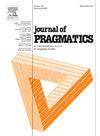Orienting to knowledge as remarkable: The newsmark be'emet (‘in-truth’) in Hebrew conversation
IF 1.7
1区 文学
0 LANGUAGE & LINGUISTICS
引用次数: 0
Abstract
The paper examines a practice of responding to informing actions implemented by the Hebrew form be'emet (lit. ‘in truth’). Based on everyday conversation data, it argues that the newsmark be'emet attributes remarkability, of whatever degree or valence, to the prior speaker's informing. This can be done to endorse a similar stance already offered by the informer, or it can be independently proffered by the recipient. The study shows how the negotiation of remarkability unfolds in be'emet-embedding sequences, focusing on cases where recipients use be'emet to align with their positioning as the less knowledgeable or newly informed party, as previously projected by the informer, or to withhold acceptance or contest this positioning. These different options are grounded in the epistemic and social positioning of the informer and recipient and are contextualized through the multimodal design of the be'emet-turn. The study proposes that the lack of specificity of be'emet is an affordance of such a response token since it opens up the possibility of combinedly dealing with other exigencies established by the larger activity, as well as allowing for an off-record negotiation of problems of epistemic alignment between the parties. On a broader level, the paper highlights how more general analyses of response tokens in the field of pragmatics can be enhanced by micro-analytic investigations of individual newsmarks within their local sequential context.
以非凡的知识为导向:希伯来语对话中的新闻标记be'emet(“真实”)
本文考察了对希伯来语形式be‘emet(字面意思为’ in truth ')实施的通知行动作出回应的实践。基于日常会话数据,本文认为新闻标记的显著性,无论其程度或效价,都归因于前一个说话者的告知。这样做可以支持举报人已经提供的类似立场,也可以由接收者独立提供。该研究显示了显著性的谈判是如何在“嵌入”序列中展开的,重点关注的是接受者使用“嵌入”来与他们作为知识较少或新被告知的一方的定位保持一致的情况,正如告密者之前所预测的那样,或者拒绝接受或质疑这一定位。这些不同的选择基于告密者和接受者的认知和社会定位,并通过多模态设计将其语境化。该研究提出,缺乏满足的特异性是这种响应令牌的一个优势,因为它开辟了联合处理由更大活动建立的其他紧急情况的可能性,并允许对各方之间的认识一致性问题进行非记录协商。在更广泛的层面上,本文强调了如何通过对个别新闻标记在其局部顺序上下文中的微观分析调查来加强语用学领域中对回应标记的更一般分析。
本文章由计算机程序翻译,如有差异,请以英文原文为准。
求助全文
约1分钟内获得全文
求助全文
来源期刊

Journal of Pragmatics
Multiple-
CiteScore
3.90
自引率
18.80%
发文量
219
期刊介绍:
Since 1977, the Journal of Pragmatics has provided a forum for bringing together a wide range of research in pragmatics, including cognitive pragmatics, corpus pragmatics, experimental pragmatics, historical pragmatics, interpersonal pragmatics, multimodal pragmatics, sociopragmatics, theoretical pragmatics and related fields. Our aim is to publish innovative pragmatic scholarship from all perspectives, which contributes to theories of how speakers produce and interpret language in different contexts drawing on attested data from a wide range of languages/cultures in different parts of the world. The Journal of Pragmatics also encourages work that uses attested language data to explore the relationship between pragmatics and neighbouring research areas such as semantics, discourse analysis, conversation analysis and ethnomethodology, interactional linguistics, sociolinguistics, linguistic anthropology, media studies, psychology, sociology, and the philosophy of language. Alongside full-length articles, discussion notes and book reviews, the journal welcomes proposals for high quality special issues in all areas of pragmatics which make a significant contribution to a topical or developing area at the cutting-edge of research.
 求助内容:
求助内容: 应助结果提醒方式:
应助结果提醒方式:


